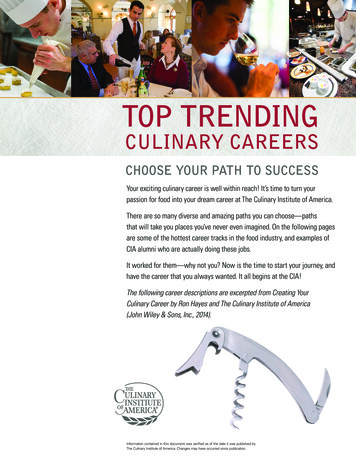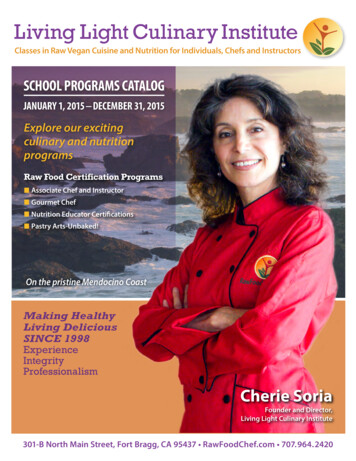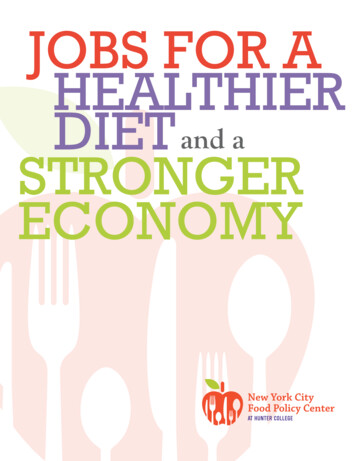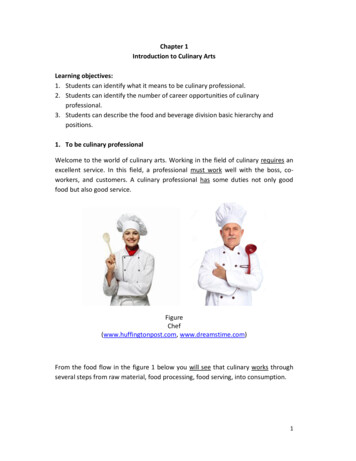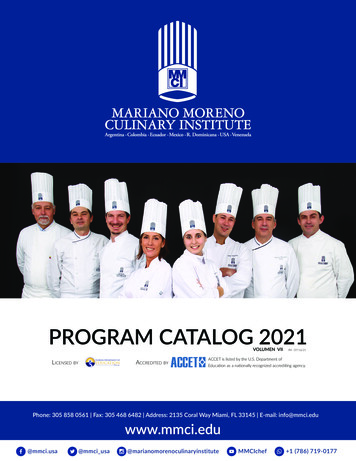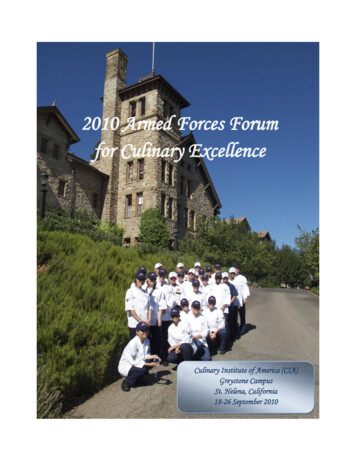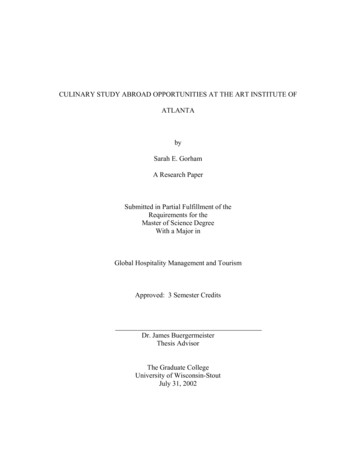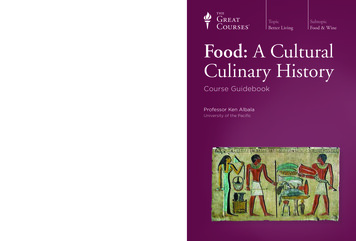
Transcription
TopicBetter Living“Pure intellectual stimulation that can be popped intothe [audio or video player] anytime.”—Harvard MagazineFood: A Cultural Culinary History“Passionate, erudite, living legend lecturers. Academia’sbest lecturers are being captured on tape.”—The Los Angeles Times“A serious force in American education.”—The Wall Street JournalProfessor Ken Albala is Professor of History at the Universityof the Pacific in Stockton, California, where he teaches foodhistory and the history of early modern Europe. He has anM.A. in History from Yale University and a Ph.D. in Historyfrom Columbia University. Professor Albala is the author oreditor of numerous books on food and coeditor of the journalFood, Culture & Society. His textbook Three World Cuisines:Italian, Mexican, Chinese won the 2013 Gourmand WorldCookbook Award for Best Foreign Cuisine Book in the World.Professor Photo: Jeff Mauritzen - inPhotograph.com.Cover Image: Erich Lessing/Art Resource, NY.Course No. 9180 2013 The Teaching Company.PB9180AGuidebookTHE GREAT COURSES Corporate Headquarters4840 Westfields Boulevard, Suite 500Chantilly, VA 20151-2299USAPhone: 1-800-832-2412www.thegreatcourses.comSubtopicFood & WineFood: A CulturalCulinary HistoryCourse GuidebookProfessor Ken AlbalaUniversity of the Pacific
PUBLISHED BY:THE GREAT COURSESCorporate Headquarters4840 Westfields Boulevard, Suite 500Chantilly, Virginia 20151-2299Phone: 1-800-832-2412Fax: 703-378-3819www.thegreatcourses.comCopyright The Teaching Company, 2013Printed in the United States of AmericaThis book is in copyright. All rights reserved.Without limiting the rights under copyright reserved above,no part of this publication may be reproduced, stored inor introduced into a retrieval system, or transmitted,in any form, or by any means(electronic, mechanical, photocopying, recording, or otherwise),without the prior written permission ofThe Teaching Company.
Ken Albala, Ph.D.Professor of HistoryUniversity of the PacificProfessor Ken Albala is Professor of Historyat the University of the Pacific in Stockton,California, where he has been teaching foodhistory and the history of early modern Europe forthe past 20 years. In 2009, he won the Faye andAlex G. Spanos Distinguished Teaching Awardat the University of the Pacific. He is also a Visiting Professor at BostonUniversity, where he teaches an advanced food history course in thegastronomy program. He has a B.A. in European Studies from The GeorgeWashington University, an M.A. in History from Yale University, and aPh.D. in History from Columbia University.Professor Albala is the author or editor of 16 books on food, including EatingRight in the Renaissance; Food in Early Modern Europe; Cooking in Europe,1250–1650; The Banquet: Dining in the Great Courts of Late RenaissanceEurope; Beans: A History (winner of the 2008 International Association ofCulinary Professionals Jane Grigson Award); and Pancake: A Global History.He also has coedited The Business of Food: Encyclopedia of the Food andDrink Industries, Human Cuisine, and two other collections: Food and Faithin Christian Culture and A Cultural History of Food in the Renaissance.Professor Albala was editor of three food series for Greenwood Presswith 30 volumes in print, and his four-volume Food Cultures of the WorldEncyclopedia was published in 2011. He is also coeditor of the journal Food,Culture & Society and general editor of the series AltaMira Studies in Foodand Gastronomy, for which he has written a textbook entitled Three WorldCuisines: Italian, Mexican, Chinese, which won the 2013 Gourmand WorldCookbook Award for Best Foreign Cuisine Book in the World.Professor Albala is currently researching a history of theologicalcontroversies surrounding fasting in the Reformation era. Recently, hei
coauthored a cookbook, The Lost Art of Real Cooking, and its sequel, TheLost Arts of Hearth and Home, a handbook of kitchen and home projects. ii
Table of ContentsINTRODUCTIONProfessor Biography .iCourse Scope .1LECTURE GUIDESLECTURE 1Hunting, Gathering, and Stone Age Cooking.4LECTURE 2What Early Agriculturalists Ate.12LECTURE 3Egypt and the Gift of the Nile.20LECTURE 4Ancient Judea—From Eden to Kosher Laws.28LECTURE 5Classical Greece—Wine, Olive Oil, and Trade .36LECTURE 6The Alexandrian Exchange and the Four Humors.43LECTURE 7Ancient India—Sacred Cows and Ayurveda .50LECTURE 8Yin and Yang of Classical Chinese Cuisine .57LECTURE 9Dining in Republican and Imperial Rome .65LECTURE 10Early Christianity—Food Rituals and Asceticism .72iii
Table of ContentsLECTURE 11Europe’s Dark Ages and Charlemagne .78LECTURE 12Islam—A Thousand and One Nights of Cooking .85LECTURE 13Carnival in the High Middle Ages.92LECTURE 14International Gothic Cuisine .99LECTURE 15A Renaissance in the Kitchen .106LECTURE 16Aztecs and the Roots of Mexican Cooking . 113LECTURE 171492—Globalization and Fusion Cuisines.120LECTURE 1816th-Century Manners and Reformation Diets .127LECTURE 19Papal Rome and the Spanish Golden Age .134LECTURE 20The Birth of French Haute Cuisine .143LECTURE 21Elizabethan England, Puritans, Country Food.150LECTURE 22Dutch Treat—Coffee, Tea, Sugar, Tobacco .158LECTURE 23African and Aboriginal Cuisines .165iv
Table of ContentsLECTURE 24Edo, Japan—Samurai Dining and Zen Aesthetics.172LECTURE 25Colonial Cookery in North America.178LECTURE 26Eating in the Early Industrial Revolution .185LECTURE 27Romantics, Vegetarians, Utopians .192LECTURE 28First Restaurants, Chefs, and Gastronomy .199LECTURE 29Big Business and the Homogenization of Food.206LECTURE 30Food Imperialism around the World .213LECTURE 31Immigrant Cuisines and Ethnic Restaurants .220LECTURE 32War, Nutritionism, and the Great Depression .227LECTURE 33World War II and the Advent of Fast Food.234LECTURE 34Counterculture—From Hippies to Foodies .241LECTURE 35Science of New Dishes and New Organisms .248LECTURE 36The Past as Prologue? .255v
Table of ContentsSUPPLEMENTAL MATERIALBibliography .261vi
Food: A Cultural Culinary HistoryScope:This course explores the history of how humans have produced,cooked, and consumed food—from the earliest hunting-and-gatheringsocieties to the present. This course examines how civilizations andtheir foodways have been shaped by geography, native flora and fauna, andtechnological innovations. Feeding people has always been the primaryconcern of our species, and more than any other factor, finding, growing, andtrading food products has been the prime catalyst in human history. Think,for example, how the desire for spices in the Middle Ages led directly to thediscovery of the New World.The scope of this course is global, covering civilizations of Asia, America,Africa, and Europe and how cultures in each of these continents domesticatedunique staples that literally enabled these civilizations to expand and flourish.The course also covers marginalized and colonized cultures that weredominated largely to feed or entice the palates of the great. A major themeof the course is the process of globalization, imperialism, and the growth ofcapitalist enterprise at the cost of indigenous cultures and traditional farmingpractices and how these processes were shaped by trade in food.Beyond the larger economic and social issues, the course will also cover theculture of food, why humans made the food choices they have, and whattheir food practices tell us about them and their world. In other words, foodpractices will be used as a window for viewing culture as a whole—just asone might study painting or literature. Foodways reveal much more becausenot only must all humans eat, but they also all make conscious choices aboutfood within a cultural milieu. These choices not only reveal who they areand where they fit in socially, but also often their political, religious, andphilosophical bend. By exploring what humans have thought and writtenabout food, you will hopefully be able to experience human history as itbecomes alive and direct in a way that the stories of great kings and epicbattles sometimes cannot.1
This course will examine in detail cookbooks, culinary literature, and dietaryand religious texts—all of which reveal the preoccupations and predilectionsof the past. The course will also examine why different people make differentfood choices, why they sometimes go to extraordinary lengths to find rare orexotic items while refusing to eat foods that are cheap and plentiful, whyindividuals from certain social classes will avoid or esteem particular foods,and in general how food is the most important factor of self-definition. Inother words, food helps define who the individual is; where he or she fitsin society; and how the culture, nationality, or ethnicity he or she espousesexpresses itself through food and cuisine. Of course, what a particular foodor dish may mean differs dramatically from place to place and time to time,from generation to generation, and even in the mind of one individualdepending on the context. This course will help you see not only how andwhy other cultures shape what people eat, but also how your choices areultimately determined by our culture and are often equally bizarre andarbitrary to outsiders, especially when it comes to food taboos.ScopeBecause this is a history course, it will examine the way that the interaction,destruction, transformation, and assimilation of cultures are all hastened bythe human drive to feed and titillate the gullet. For example, the demandfor sugar and spices in the late Middle Ages was not only the impetus fordiscovering the New World, but it also transformed the economy of boththe Old World and the New World and involved massive migrations, thespread of human pathogens, and the biological interaction of flora, fauna,and humans among several continents. All of this changed the world—sothat Europeans could have sugar in their tea.The entire course is also accompanied by hands-on activities so that youcan not only read about food in the past in the lecture guides, but you canalso have some fun in the kitchen exploring the past and even tasting it ifyou so desire. The activities are designed to bring the lectures alive—notonly by having you experience the physical act of cooking as it was done inthe past, but also by having you understand directly the taste preferences ofour forebears. Of course, using equipment that would have been used in thepast helps you get much closer, as does using exactly the ingredients theywould have used, but there is no reason not to try these activities in yourmodern kitchen as well. Some of these activities involve recipes that were2
taken directly from historic cookbooks. Reconstructions are given whenrecipes were not available or have never been translated. Others are simplyculinary exercises or tastings. They are all designed to expand your palate, toexplore the past—just as you might a new, exotic cuisine you have recentlydiscovered. All recipes have either been adapted from the original or aredirect translations from the original languages. 3
Hunting, Gathering, and Stone Age CookingLecture 1TLecture 1: Hunting, Gathering, and Stone Age Cookinghroughout this course, you will analyze what people ate and why, howthey made the best of their material resources, which technologiesthey used to transform food, and most importantly, what ideas theyhad about food. By the end of the course, your relationship to the foodyou eat—and to human history as a whole—may be quite different and,hopefully, far richer. This lecture begins at the very beginning, even beforehuman history, with a discussion of food in prehistoric times.Prehistoric Diets Looking at the diet of prehistoric people raises fundamentalquestions about what we were meant to eat according to nature. Thisis a question that most civilizations at one point or another address:Are we primarily sharp-toothed carnivores or benign vegetarians?4 It had long been assumed that our prehistoric forebears wereprimarily hunters, judging from archaeological remains of animalbones and arrow tips and pictures of game depicted on cave walls.However, from the emergence of Homo sapiens about 200,000years ago to only about 10,000 years ago—the vast majorityof our time on this planet—humans got their food by gatheringand hunting. Humans are omnivores—and always have been. Sophisticatedmethods of analyzing tissue remains and fossilized bits of foodare now giving us a more complete image of the prehistoric diet,and the surprise is that prehistoric humans were well fed; they ateeverything and anything that offered nutritional value, includingmeat of animals large and small, insects, fish, wild greens, nuts,berries, and seeds. Other evidence is provided by plant and animal remains left atarchaeological sites, including bits of bones, heaps of shells, and
traces of bug exoskeletons. When you find a huge pile of bonesof a particular species that are burned, broken, and discarded in aheap, it’s good evidence that it was a regular part of the diet andthat hunters brought back their kill to a central place to butcher itand probably shared it communally. Wall paintings, such as those in Lascaux in France and Altamirain Spain, reveal which species were hunted—some of which arenow extinct, including woolly mammoths, or no longer live in theregion because they were overhunted, or the climate changed sodramatically that they couldn’t survive or feed themselves. Anthropologists also infer information about prehistoric diets andcooking methods by comparing modern-day peoples still livingin traditional ways, including Amazonian tribes and aboriginalAustralians, and drawing inferences about prehistoric peoplesfrom them.Human Evolution There have been a lot of recent discoveries in paleontologyregarding human evolution. The story of how we became humanis all about food: hunting, processing ingredients, and cooking.The story of human evolution itself is largely a story of changestriggered by different modes of food processing. The last common ancestor of humans and apes seems to have livedbetween 5 and 10 million years ago. Both were omnivores, but aparting of the ways in the quest for food, in a sense, made us whatwe are. Ardipithecus ramidus, discovered in 1994, is the oldesthominid. Ardipithecus ramidus lived about 5 million years ago, wasabout four feet tall, walked upright, and lived in forests. Bipedalism, the fact that hominids walk on two feet, is thoughtto be the result of the need to move faster and see farther whenhominids began to move onto the plains and catch larger animals orescape from predators. In other words, how we ate (on the plains)directly drove evolution. Shorter hominids that walked with their5
6 The first cultural changes related to food appeared about 2.5 to1.5 million years ago with Homo habilis, or “handy man.” He wasfound with tools around him, such as flaked stones for cutting.Homo habilis had a bigger brain, and the Broca’s area of the brainwas larger, so he probably could speak a bit, too. Homo habilis probably made the transition from a diet comprisedprimarily of unprocessed plant foods to a greater amount of meat inthe Pleistocene era, about 1.5 million years ago. Meat was acquiredjust as often by scavengingas hunting. Homo erectus lived from 1.8million to 300,000 years agoand is found outside Africa andin Europe. Homo erectus wereprobably better walkers thanwe are; our pelvises are muchwider to allow for the birth ofinfants with big brains. About700,000 years ago, there’sdirect evidence of hunting.Mostimportantly,Homoerectus probably used fire. Recently, Richard Wranghamhas made the argument that Homo erectus is perhaps anHomo erectus also cooked food, ancestor of modern humans.and this made available manymore nutrients, which allowed us to spend less energy digestingraw food and more energy developing greater brain capacity. Inother words, we evolved because we cooked food. Dorling Kindersley RF/Thinkstock.Lecture 1: Hunting, Gathering, and Stone Age Cookingknuckles on the ground couldn’t compete and, therefore, died off.Meanwhile, apes stayed in forests.
Archaic forms of Homo sapiens first appeared about 500,000 yearsago. For example, Neanderthals lived from 320,000 to 30,000 yearsago. They are closely related to us—so close that we could produceoffspring with them. The brains of Neanderthals were a little bigger than ours. They werestout but short (about 5’ 6’’) with a solid build, and they adaptedto living in colder climate of the last major ice age. They used awide variety of tools and weapons. They were hunters of big game,and most importantly, Neanderthals cooked their food—from about250,000 years ago—and show the oldest undeniable evidence ofwidespread cooking of food, which is about 125,000 years old. Homo sapiens sapiens only appeared 120,000 years ago; we livedat the same time as Neanderthals. About 40,000 years ago, CroMagnon man was making tools for sewing clothes, sculpting,decorating beads and ivory carvings, clay figures, instruments, andcave paintings. It’s only here that there’s evidence of sophisticatedhunting strategies. They also took on dangerous animals, such aswild boar and woolly mammoths. When we get to 30,000 B.C., or the Paleolithic Period (OldStone Age), we are the only hominid left. Presumably, ouradvanced organizational skills gave us a distinct advantage overthe Neanderthals, and it may have been partly the advantage ofsophisticated cooking and socializing.Hunting-Gathering Life Ninety percent of humans who have ever lived were gatherersand hunters. Although hunter-gatherers were more closely tied tothe larger ecosystem along with other animals, it would be wrongto assume that they lived in some kind of primeval harmony withnature. They destroyed fields through burning, hunted animals toextinction, and caused pollution. Given the extremely low population density, however, they didn’tdo that much damage. About a million years ago, there were about7
Lecture 1: Hunting, Gathering, and Stone Age Cookinghalf a million hominids in existence; by 30,000 years ago, therewere about three million. Despite the smaller populations, huntergatherers were on the whole better nourished, had fewer diseases,and probably had a lot more spare time than their agriculturalpastoral descendants.8 Regarding free time, a hunting-gathering economy provides about10,000 to 15,000 calories per hour of labor. Subsistence farmers,growing mostly grain, get between 3,000 and 5,000. You have towork much harder when farming—and you have to eat a lot morevegetables to be properly nourished. To capture or kill an animal requires a high level of sophistication.Making such tools as bows and arrows are skills that are passeddown from generation to generation. Presumably, these skills givesome peoples an evolutionary advantage over others, and thismay be why we replaced Neanderthals. Sophisticated toolmakerssurvive and pass on their genes at a greater rate. It is generally believed that there was a gender-specific divisionof labor among these people—as there often is among nomadichunter-gatherers today. Men went out to hunt while women did thegathering because they were also involved with child rearing. Cooking was essential to our becoming human and was the firstmajor food revolution. Cooking involves the development ofritual, and a more complex social organization results from regularcooking with fire. Many foods, including meat, starches, and wildgrasses, were made more digestible (or digestible for the first time)with the advent of cooking with fire. Cooking also kills pathogensin food, so those who cooked survived at greater rates than thosewho didn’t—a real evolutionary advantage over all other animals. In fact, even before pottery and metallurgy, a core repertoire ofcooking methods had already come into use. Roasting.
Using a hot stone as a griddle. Filling a pit with stones and covering it with leaves and earth. Filling a basket with water and hot stones. Stretching skin with water over a fire. Filling a stone-lined pit (below the water table) with water andhot rocks or smeared with clay and fired. Stuffing entrails with other foods. Placing food on a wooden rack over hot coals in a pit (barbequing). What was eaten depends entirely on the region, but there are somegeneralizations that can be made. The first major distinction isbetween those living near water and those inland in open grasslands,where there are animals in herds. The inland people generally haveto move farther and more frequently than the coastal people. Another generalization is that colder arctic and more northernregions tend to have a narrower diet, like Eskimos on seals and fish.In more tropical regions, the diet is much more varied with a greatermix of vegetables, fruits, and meats. Bigger jaws holding bigger muscles suggest rougher and rawerfood; smaller jaws of more recent humans suggest softer andcooked food. There are more cavities, too, with the agriculturalist’sdiet of starches and sugars. Hunter-gatherers have more worn frontteeth and canines; agriculturalists’ molars wear down more quickly. For more than 100,000 years, virtually everything humans ate waswild. The animal species they ate were leaner, and the roots andvegetables were stronger tasting, with all the fiber and roughageintact. They also ate a lot of nuts and berries, which many peopletoday claim are very good for your health.9
Suggested ReadingAnderson, Everyone Eats.Fraser, Empires of Food.Higman, How Food Made History.Jones, Feast.Montanari, Food Is Culture.Wrangham, Catching Fire.Lecture 1: Hunting, Gathering, and Stone Age CookingCulinary ActivityBoiling Water in a Paper BagHere’s an interesting exercise that simply shows how one can cook in ananimal skin. Take a large paper shopping bag, and cut out an eight-by-eightinch square with no seams. (Seams would cause it to leak.) Fold it in halfdiagonally once into a triangle, and then fold it again in half into a smallertriangle. Open it up so that you have a cone, and tape or staple the ends sothat it doesn’t unfold. Notice that one side will be thicker than the other;that’s fine, it will hold water. Next, fill the cone halfway up with water, andplace it immediately over a burning candle. In a few minutes, the waterinside will boil, and the paper will not burn. This replicates the technique ofcooking in an open skin stretched over a fire. If you have the patience, trycooking a carrot in the boiling water.Pit CookingTo get a sense of how people cooked in prehistoric times, first find an openspot with soil soft enough to dig, at least 20 feet from any trees or buildings.Dig a circular hole about three feet deep. Line the perimeter of the pit withlarge stones for safety purposes and so that you can balance sticks across thepit. Make a fire inside the pit, starting with small kindling and building upto larger logs. When they have burned down to coals, you can start cooking.This is the original way to barbecue, incidentally.10
You want to cook long and slow, but because this is before the discovery ofmetallurgy, you need to make a lattice using fresh green sticks. Lay themacross the pit in one direction, and then lay more in the other direction so thatyou have a kind of primitive grill. They should be far enough away from thehot coals so that they don’t burn, but they probably will char a little. Place ontop of the sticks any meat you prefer: a few split chickens, large cuts of porkshoulder, or even a fish wrapped in sturdy leaves. Your seasoning should beminimal—whatever herbs you can find and salt. Because you are using avery gentle fire, expect larger pieces of meat to cook for at least an hour orso. If you have a flare-up, you can always sprinkle a little water on the fire toprevent the meat from burning. It will smoke a lot, which is good. Smoke isunquestionably a major flavor category that we have learned to enjoy in themillennia of cooking in this way.11
What Early Agriculturalists AteLecture 2The agricultural revolution is probably the single most important eventin human history. In fact, there were several agricultural revolutionsat different times around the globe, and it was not one event, but along and gradual process wherein people made the shift from the nomadichunting-gathering way of life to the sedentary agricultural—and civilized—way of life. In this lecture, you will learn how ancient peoples figured out away to support their growing population by moving toward an agriculturalbased society.Lecture 2: What Early Agriculturalists AteThe Beginning of the Agricultural Revolution Late-18th-century philosopher and economist Thomas Malthusbelieved that like all animals, human populations are subject to theavailability of resources. A population can only grow as fast as theresources can feed the new mouths. If it gets too large, many willnaturally die off, and if resources are abundant, then the populationwill naturally grow faster.12 In prehistoric times, even if a new technology like agriculture isinvented, the population will rise dramatically but still be limitedby whatever that new technology can produce. Malthus noted thatagriculture can only be increased arithmetically while populationincreases exponentially. Even if population pressure forced some people to find new waysof getting food, it did not free them from the recurrent crises,food shortages, and famines. In fact, in certain respects, it madethose worse because they were now depending on far fewerplants: If a crop failure ruined one single species, there could bea major devastating famine whereas before, no one species wasdepended on, so if one thing was missing, they gathered or huntedsomething else.
Apart from population pressure being a possible catalyst, resourcesthey had been depending on suddenly become scarce. This isprobably the initial catalyst. It may seem odd, but in those huntingand gathering days, the Earth was also in the tail end of the lastmajor ice age, which meant that humans were relatively confined tothe warmer parts of the Earth and closer to the tropics, but so werethe animals they hunted and the plants they depended on. When the Earth began to get warmer—from about 60 degreesin summer to about 80 or more—there was more food and morefields. What used to be great frozen glaciers became lush prairies.The animal populations were no longer contained. Because thevegetation grew more easily, the gathering was much better forhumans, too, so their populations also grow. However, suddenly, they are out of balance. Hunting is harder, andgathering is easier. More mouths to feed means greater pressureto increase yield. Historians guess that plants were domesticated,which means to actively change a species to accentuate certaindesired traits until that species no longer resembles the plant thatgrew in the wild. Dogs were probably the first animals to be domesticated, byaccident, following around human camps for scraps and providingsome watch from other predators. Not only can these animalsbe trained to stay in herds, but they also are ruminants, which isimportant because they can be fed grass (which humans can’t eat)instead of other animals.The Spread of the Agricultural Revolution About 10,000 years ago, the first place the agricultural revolution hitwas the region called the Fertile Crescent, an arc covering what istoday Iraq, Syria, eastern Turkey, Lebanon, and Israel. This regionjust happened to luck out by having a lot of easily domesticatedplants and animals, including goats, sheep, and cows, which offermeat, wool, hides, milk, and cheese. These types of animals provideinsurance, traction, transport, and manure (fertilizer).13
Design Pics/Thinkstock.Lecture 2: What Early Agriculturalists AteWheat, one of the most important cereal crops, can be grown in a wide variety ofclimates and soils.14 In addition, there is the wild ancestor of wheat all over the FertileCrescent. Einkorn, spelt, and emmer have a relatively high proteincontent, so they can become staple crops. They contain about 8to 14 percent protein, not nearly as much as meat, but people canlive on it as the base of their diet. It can also be stored. Withoutwheat, civili
His textbook Three World Cuisines: Italian, Mexican, Chinese won the 2013 Gourmand World Cookbook Award for Best Foreign Cuisine Book in the World. Food & Wine Sutoi Better Living Toi Food: A Cultural Culinary History Cours uidoo Professor Ken Albala nirsity o t ai THE GREAT COURSES Co
